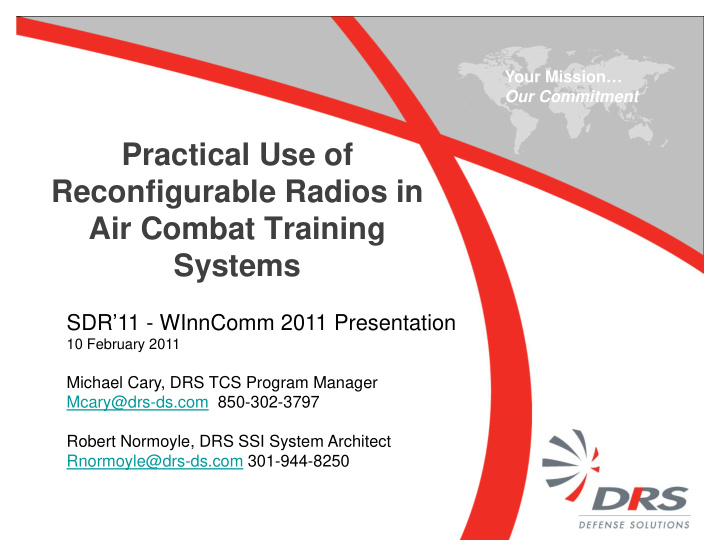



Your Mission… Our Commitment Practical Use of Reconfigurable Radios in Air Combat Training Systems SDR’11 - WInnComm 2011 Presentation 10 February 2011 Michael Cary, DRS TCS Program Manager Mcary@drs-ds.com 850-302-3797 Robert Normoyle, DRS SSI System Architect Rnormoyle@drs-ds.com 301-944-8250
Today’s Overview SDR Interoperability and Reconfigurable Concepts • Identifying a reference Platform and Target Radio • Waveform Modeling • Development Flow and Verification • Major Challenges • Software Configuration Architecture • Conclusion 2
DRS Air Combat Training SDR Goals • Per The Net-centric Enterprise Solutions for Interoperability (NESI v3.1) best practices (BP 1880, rev 5) in 2009: “ Justify, document, and obtain a waiver for all radio terminal acquisitions that are not JTRS/SCA compliant.” • Many US tactical and strategic data links may be upgraded to JTRS • DRS goal – upgrade product radio links to JTRS/SCA standards: best practice. • DRS internal investment for advanced SDR data link: • JTRS/SCA compliant • Support legacy waveforms and future waveform(s) • Consolidate HW baselines, increase waveform baselines via reconfigurable SDR • Focus on airborne networks of the Test and Training community • Prepare airborne training instrumentation for GIG interface. 3
Legacy Waveform Overview POWER AMP MODEM RADOME AIR FORCE AIR FORCE TDMA DATA LINK SUPPORTS : • Rangeless Operations • Live Monitor • Live Monitor with Control • Fixed Range Operations • Shipboard Operations • Includes relay and is self-forming/healing NAVY NAVY 4
Training Waveform Characteristics • Link success: 99% • Bit Error Rate (BER): 10 -6 (max). • Frequency: Upper L-band and S-band • Network: TDMA with 330 slots per second • Modulation: Minimum Shift Keying (MSK) • Bandwidth: 2.0 MHz; 99% power bandwidth • Waveform char: buffer time, preamble, header and CRC • Encoding: Viterbi and convolutionally interleaved. 5
Identifying a Target Platform (Dec 2009) • Summarized Assessments from 58 Point Standard • Evaluation Criteria on 19 Issues • Does not meet requirements • Meets some requirements • Meets requirements • Exceeds requirements $$$ A TRL 8 $$$$$$ B TRL 9 $ C TRL 6 $ D TRL 6 6
DRS-SS Overview Surveillance Receivers Applications: F/TDOA Geolocation HF to 40 GHz Wireless Demods SI -9155 Picoceptor SI -8500 2 MHz to 3 GHz 2 to 40 GHz 250 MHz to 26 GHz Freq Ext to 12 GHz Software Definable Transceivers SI -7051 DART 2 MHz - 3 GHz 2 MHz-6 GHz High Speed Digital Recorders 7
DART SDR Overview DART • D RS Defense Solutions • A dvanced • R adio • T ransceiver Specifications: Frequency range: 400-3000 MHz Bandwidth: 25 MHz Size: 5” x 6” x 0.9” Weight: < 2 lbs Interfaces: USB 2.0 OTG, RS-232, 1 PPS, 10 MHz Processor: Xilinx V4FX60 8
DART Block Diagram 9
Waveform Processing Modulation and Demodulation Functional blocks: •Preamble Generator/Detection • Frequency/Phase Estimation • Resampler/Rate Adjustment • Timing/Slot Controller • Convolution Encoding/Decoding • Interleaver/De-Interleaver • Modulation Mapper (BPSK, MSK, etc.) • CRC Generator/Checker 10
DRS Waveform Porting Process DRS Defense Solutions Waveform Porting Process Demonstrated • Functionally compatible HW platform • Functionally compatible software architecture • Integrated toolset flow from modeling thru test 11
Laboratory analysis of transmitter MXA Analyzer provided invaluable feedback on transmitters operation: 1. Spectrum characteristics 2. Constellation shape 3. Error Vector Magnitude 4. Preamble content 5. Time length 6. Number of bits 7. Data pattern 12
DART Performance Validated Proved Performance in three phases: • RF Performance Validation Nov 2010 • Modem Transmitter Validation May 2011 • Demonstrated TSPI Data July 2011 13
Summary of Waveform Porting Approach Accomplished: • Model P5 legacy waveform with SIMULINK • Validate RF performance of DART • Port P5 legacy waveform to DART (Altera to Xilinx) • Verify performance of DART waveform is compatible with legacy P5 pod Future: • Integrate into product baseline as tech refresh • Enhance network with new SDR waveforms and capability 14
Demonstrations Setup Analysis & Survey Tool Vector Signal Analyzer Modem CDU Display DLT Performance Measurement DLT Performance Execution 5th Generation AC P5 Internal P5 Pod DART Modem Sub-system Modem 15
DART SDR Demon CDU Analyzer Out of Net 16
Analyzer 17
DART SDR Demon CDU Analyzer Out of Net 18
CDU 19
DART SDR Demon CDU Analyzer Out of Net 20
Out of Network 21
DART SDR Demon CDU Analyzer Out of Net 22
Lessons Learned • Establishing the correct documentation for a 20+ year old waveform can be like a reverse engineering effort. Use of vendor specific SIMULINK tools slowed down the porting process • • Recommend selecting a SIMULINK primitives and blocks that are FPGA and DSP hardware and vendor independent Recommend waveform designs easily allow different clock rates, such as: • • Reference clock • ADC & DAC clock 23
Conclusion • There is a need for SDR architectures for range telemetry modem • Support legacy waveforms • Modern waveforms • Migrate to new frequencies to accommodate re-allocation A waveform porting process was developed using SIMULINK and MXA as • • Porting tools • Waveform validation tools • DART is a viable SDR platform for • Transmitter waveform was ported and tested with legacy hardware • DLT legacy waveform used in air combat training • Future JTRS waveforms • Multiple airframe platforms 24
Recommend
More recommend